1. Hay SI, Abate KH, Abbafati C, Abbas KM, Abd-Allah F, Abdulkader RS, et al. Global, regional, and national disability-adjusted life-years (DALYs) for 333 diseases and injuries and healthy life expectancy (HALE) for 195 countries and territories, 1990–2016: a systematic analysis for the Global Burden of Disease Study 2016. Lancet. 2017; 390(10100):1260–1344. PMID:
28919118.
2. Haddon W Jr. The changing approach to the epidemiology, prevention, and amelioration of trauma: the transition to approaches etiologically rather than descriptively based. Am J Public Health Nations Health. 1968; 58(8):1431–1438. PMID:
5691377.

3. Krug EG, Sharma GK, Lozano R. The global burden of injuries. Am J Public Health. 2000; 90(4):523–526. PMID:
10754963.

4. OECD.Stat. Health status: external causes of mortality. Updated 2020. Accessed 2020 September 28.
https://stats.oecd.org/
.
5. Hong S, Kim B, Bae J, Oh J, Jo M, Kim S, et al. Epidemiological characteristics of injured inpatients in Korea. Public Health Wkly Rep. 2015; 11(11):310–318.
6. Lee YR, Cho B, Jo MW, Ock M, Lee D, Lee D, et al. Measuring the economic burden of disease and injury in Korea, 2015. J Korean Med Sci. 2019; 34(Suppl 1):e80. PMID:
30923489.

7. Kim S. Epidemiology and control of injury. J Prev Med Public Health. 2005; 38(2):125–131. PMID:
16315748.
8. Yoon J, Oh IH, Seo H, Kim EJ, Gong YH, Ock M, et al. Disability-adjusted life years for 313 diseases and injuries: the 2012 Korean Burden of Disease Study. J Korean Med Sci. 2016; 31(Suppl 2):S146–S157. PMID:
27775252.

9. Hong SO, Kim B, Jo J, Kwon Y, Lee YK, Kim Y. Main results of the Korea national hospital discharge in-depth injury survey, 2004–2016. Epidemiol Health. 2020; 42:e2020044. PMID:
32580533.
10. Park H. Development of Preventive Indicators and Questionnaire of Injuries among Children and Adolescents. Cheongju: Korea Disease Control and Prevention Agency;2012.
11. Kim MS. Child safety and child injury prevention strategies. Health Welf Policy Forum. 2016; 44–61.
12. Becker C, Gebhard F, Muche R, Scheible S, Nikolaus T. Epidemiology of accidental falls in the elderly. Z Orthop Ihre Grenzgeb. 1999; 137(6):482–485. PMID:
10666853.
13. Kwon YJ, Ryu SY, Shin SO, Chun IA, Park MS, Shim JS. The injury and its related factors in the elderly using the data of 2008 community health survey. J Agric Med Community Health. 2014; 39(1):1–13.

14. Heinrich HW, Petersen D, Roos N, Brown JV, Hazlett S. Industrial Accident Prevention. 5th ed. New York, NY: McGraw-Hill;1980. p. 1–468.
15. World Health Organization. Injuries and Violence: the Facts. Geneva: WHO;2004.
16. Wadman MC, Muelleman RL, Coto JA, Kellermann AL. The pyramid of injury: using ecodes to accurately describe the burden of injury. Ann Emerg Med. 2003; 42(4):468–478. PMID:
14520317.
17. Han H, Park B, Park B, Park N, Park JO, Ahn KO, et al. The pyramid of injury: estimation of the scale of adolescent injuries according to severity. J Prev Med Public Health. 2018; 51(3):163–168. PMID:
29886712.

18. Kim KS, Kim SD, Lee SH. Trend of mortality rate and injury burden of transport accidents, suicides, and falls. J Prev Med Public Health. 2012; 45(1):8–13. PMID:
22389753.

19. Lee EM, Lee H, Kim H. Discharge rates and treatment outcomes of injured patients in South Korea, 2005–2016: findings from the Korean National Hospital Discharge In-depth Injury Survey. Korean Public Health Res. 2020; 46(2):45–59.
20. Kim A, Song H, Park N, Choi S, Cho J. Injury pyramid of unintentional injuries according to sex and age in South Korea. Clin Exp Emerg Med. 2018; 5(2):84–94. PMID:
29973033.

21. Kim Y, Ro YS, Shin SD, Song KJ, Hong KJ. Association between time of injury and injury severity after pediatric pedestrian injury. J Korean Soc Emerg Med. 2018; 29(1):76–84.
22. Kehoe A, Smith JE, Edwards A, Yates D, Lecky F. The changing face of major trauma in the UK. Emerg Med J. 2015; 32(12):911–915. PMID:
26598629.

23. Dinh MM, Roncal S, Byrne CM, Petchell J. Growing trend in older patients with severe injuries: mortality and mechanisms of injury between 1991 and 2010 at an inner city major trauma centre. ANZ J Surg. 2013; 83(1-2):65–69. PMID:
22882777.

24. Eun-mi L, Hyewon L, Hyekyung K. Discharge rates and treatment outcomes of injured patients in South Korea, 2005–2016: findings from the Korean national hospital discharge in-depth injury survey. Korea Inst Health. 2020; 46(2):45–59.
25. Yang BM, Kim J. Road traffic accidents and policy interventions in Korea. Inj Control Saf Promot. 2003; 10(1-2):89–94. PMID:
12772491.

26. Lee JW. Factors affecting hospitalized children’s falls – using data in the national hospital discharge in-depth survey. J Korea Acad Ind Coop Soc. 2020; 21(7):510–516.
27. Jo KH, Park J, Ryu SY. The effects of mental health on recurrent falls among elderly adults, based on Korean community health survey data. Epidemiol Health. 2020; 42:e2020005. PMID:
32023776.

28. Young L, Ahmad H. Trauma in the elderly: a new epidemic? Aust N Z J Surg. 1999; 69(8):584–586. PMID:
10472913.

30. James SL, Castle CD, Dingels ZV, Fox JT, Hamilton EB, Liu Z, et al. Global injury morbidity and mortality from 1990 to 2017: results from the global burden of disease study 2017. Inj Prev. 2020; 26(Supp 1):i96–114. PMID:
32332142.
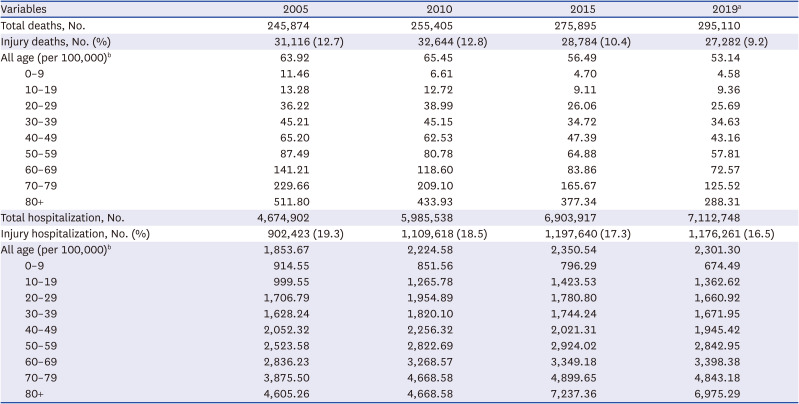
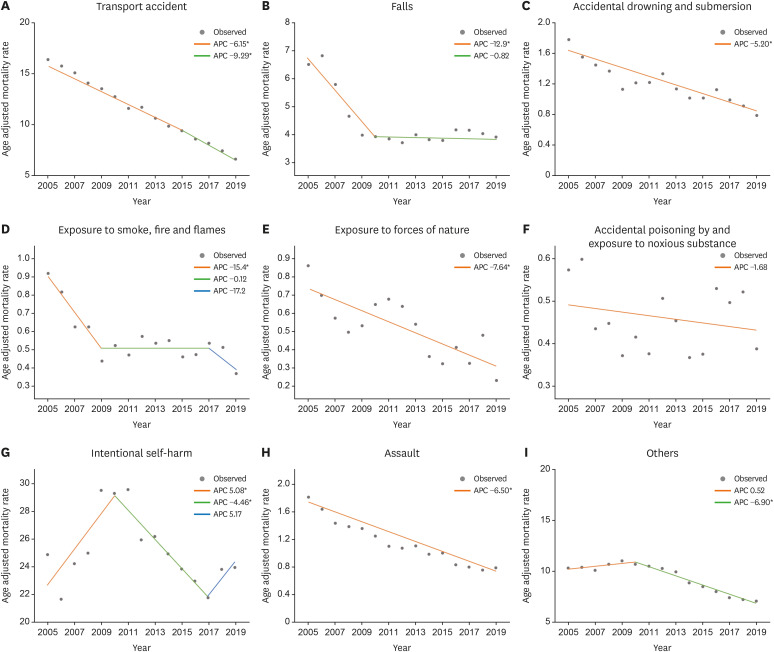
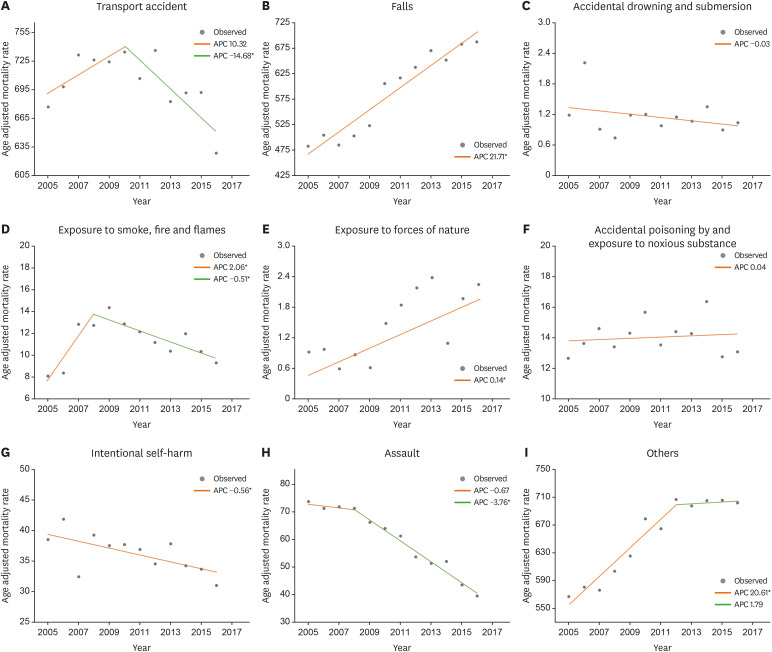




 PDF
PDF Citation
Citation Print
Print



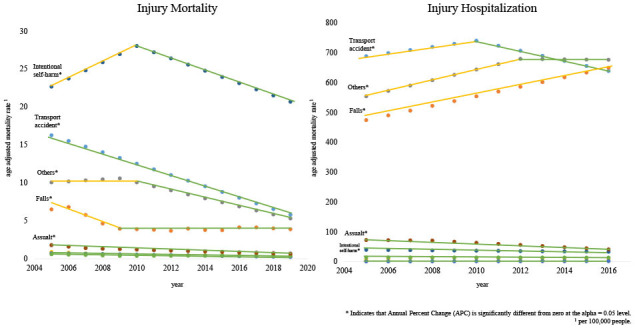
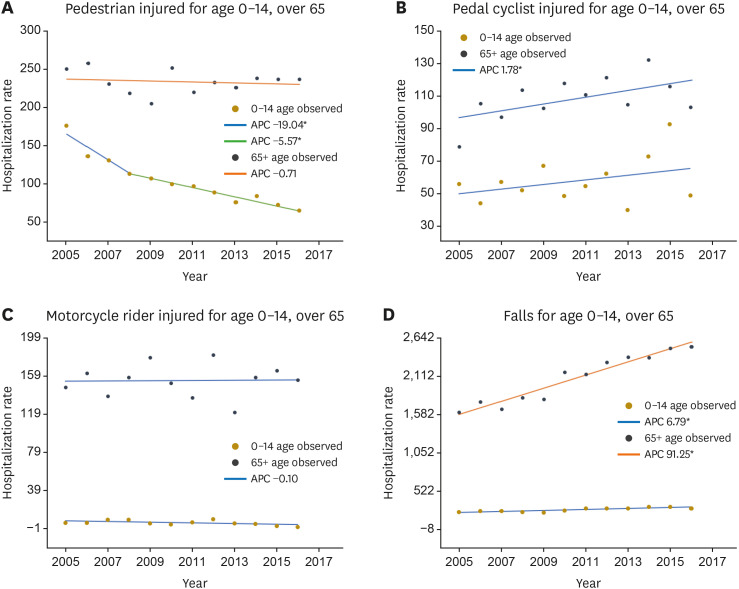
 XML Download
XML Download